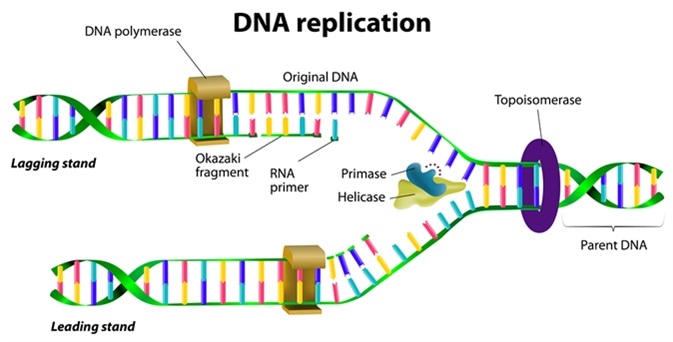DNA, or deoxyribonucleic acid, is the biological molecule that contains the information necessary to create a living organism. As the cell divides to become two, the DNA must be copied for both cells to contain the necessary genetic information. The synthesis or manufacture of new DNA strands in living cells is called "DNA replication."
Making a new strand of DNA
DNA is found as a double helix, where two strands of DNA join into two helices. The DNA replication process begins when the two strands of DNA separate. An enzyme called helicase unwinds and separates the bonds between the two strands of DNA, and both separate strands act as templates from which new DNA is made.
DNA polymerases are a group of enzymes that make new DNA. But for this enzyme to work, it needs a primer, a short nucleotide sequence that is attached to one of the DNA strands. During DNA replication, the primer is usually a short sequence of ribonucleic acid (RNA), which is then degraded and replaced by DNA.
The primer provides a 3 'hydroxyl group to which the DNA polymerase adds the DNA precursors, the nucleotides. When nucleotides are added to the 3 'end of the primer or new DNA strand, a bond is formed between the 3' hydroxyl group of the primer / new DNA and the 5 'phosphate group of the nucleotide.

There are four types of DNA nucleotides, each of which has different nitrogenous bases; adenine (A), cytosine (C), guanine (G) and thymine (T). These are always found in pairs, A-T and C-G. This is known as "Watson-Crick base pairing" and therefore if the template has an "A" nucleotide, a "T" nucleotide will be added to the growing DNA strand. If it is a "G" nucleotide, then a "C" nucleotide will be added to the growing strand.
Directionality of DNA and how it affects DNA synthesis
DNA has directionality, with one strand going from 5 'to 3' and the other going from 3 'to 5'. In the 5'-3 'strand, the 3' end is exposed during the synthesis of new DNA. This means that DNA polymerase can produce new DNA in the direction of the template DNA.
However, when it comes to the 3'-5 'support, this would leave the 5' end exposed; How does DNA polymerase deal with this? In the 3'-5 'chain, DNA polymerase produces new DNA that forms short 5'-3' fragments, called Okazaki fragments. Then a different enzyme, DNA ligase, connects the Okazaki fragments to form the new 3'-5 'DNA strand.
Proofreading
Sometimes mistakes are made when adding nucleotides to the template DNA strand. Some DNA polymerases have what is called "3'-5 'exonuclease activity". The 3'-5 'exonuclease activity, which acts against the polymerase or synthesis activity, cuts nucleotides that do not match the template. This provides a proofreading so that the new DNA strand is as accurate as possible.